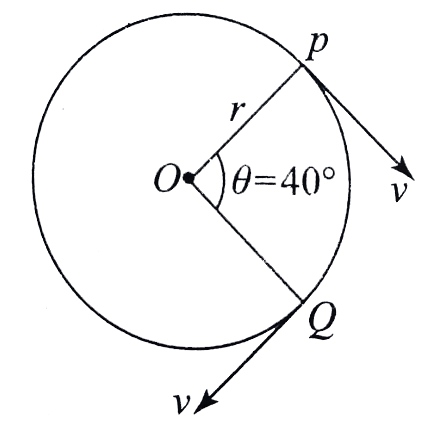A particle is moving with a constant speed in a circular path. Find the ratio of average velocity to its instantaneous velocity when the particle rotates an angle θ=(π2) .
The correct Answer is:B
To solve the problem, we need to find the ratio of average velocity to instantaneous velocity for a particle moving in a circular path when it rotates through an angle of θ=π2 radians (90 degrees).
1. Understanding the Circular Motion:
- The particle moves in a circular path with a constant speed.
- The radius of the circular path is denoted as R.
- When the particle rotates through θ=π2, it moves from point O to point M (90 degrees along the circular path).
2. Finding the Displacement:
- The displacement OM when the particle moves through π2 is the straight line connecting the starting point O and the endpoint M.
- Using the Pythagorean theorem, the displacement can be calculated as:
OM=√R2+R2=√2R2=R√2
3. Calculating Time Taken:
- The total time period T for one complete revolution is T.
- Since the particle moves through π2 (or 90 degrees), the time taken to cover this angle is:
t=T4
4. Finding Average Velocity:
- Average velocity Vavg is defined as the total displacement divided by the total time taken.
- Therefore, the average velocity when the particle moves from O to M is:
Vavg=OMt=R√2T4=4R√2T
5. Finding Instantaneous Velocity:
- The instantaneous velocity Vinst is defined as the speed of the particle at any point in time.
- The speed V for circular motion is given by:
V=2πRT
- Thus, the instantaneous velocity is:
Vinst=2πRT
6. Calculating the Ratio:
- Now, we can find the ratio of average velocity to instantaneous velocity:
Ratio=VavgVinst=4R√2T2πRT=4√22π=2√2π
Final Answer:
The ratio of average velocity to instantaneous velocity when the particle rotates through an angle of θ=π2 is:
2√2π
- The particle moves in a circular path with a constant speed.
- The radius of the circular path is denoted as R.
- When the particle rotates through θ=π2, it moves from point O to point M (90 degrees along the circular path).
- The displacement OM when the particle moves through π2 is the straight line connecting the starting point O and the endpoint M.
- Using the Pythagorean theorem, the displacement can be calculated as:
OM=√R2+R2=√2R2=R√2
- The total time period T for one complete revolution is T.
- Since the particle moves through π2 (or 90 degrees), the time taken to cover this angle is:
t=T4
- Average velocity Vavg is defined as the total displacement divided by the total time taken.
- Therefore, the average velocity when the particle moves from O to M is:
Vavg=OMt=R√2T4=4R√2T
- The instantaneous velocity Vinst is defined as the speed of the particle at any point in time.
- The speed V for circular motion is given by:
V=2πRT
- Thus, the instantaneous velocity is:
Vinst=2πRT
- Now, we can find the ratio of average velocity to instantaneous velocity:
Ratio=VavgVinst=4R√2T2πRT=4√22π=2√2π
The ratio of average velocity to instantaneous velocity when the particle rotates through an angle of θ=π2 is:
2√2π
Topper's Solved these Questions
- CIRCULAR MOTIONBOOK - DC PANDEY ENGLISHCHAPTER - CIRCULAR MOTIONEXERCISE - Exercise 10.2
7 Videos
- CIRCULAR MOTIONBOOK - DC PANDEY ENGLISHCHAPTER - CIRCULAR MOTIONEXERCISE - Exercise 10.3
4 Videos
- CIRCULAR MOTIONBOOK - DC PANDEY ENGLISHCHAPTER - CIRCULAR MOTIONEXERCISE - Miscellaneous Examples
5 Videos
- CENTRE OF MASS, LINEAR MOMENTUM AND COLLISIONBOOK - DC PANDEY ENGLISHCHAPTER - CENTRE OF MASS, LINEAR MOMENTUM AND COLLISIONEXERCISE - Level 2 Subjective
21 Videos
- COMMUNICATION SYSTEMBOOK - DC PANDEY ENGLISHCHAPTER - COMMUNICATION SYSTEMEXERCISE - Only One Option is Correct
27 Videos
Similar Questions
A particle starts from rest with constant acceleration. The ratio of space-average velocity to the time average velocity is :-
View SolutionA particle is moving with speed v in a circle of radius R. Find the magnitude for average velocity of point
for the half revolution
View SolutionA particle of mass M moves with constant speed along a circular path of radius r under the action of a force F. Its speed is
View SolutionA particle of mass m moves with constant speed v on a circular path of radius r. Find magnitude of average force on it in half revolution.
View SolutionA particle moves with constant angular velocity in a circle. During the motion its
View SolutionA car is moving in a circular path with a uniform speed v. Find the magnitude of change in its velocity when the car rotates through an angle θ.
View SolutionWhen a particle moves with constant velocity, its average velocity, its instantaneous velocity and its speed are all equal. Comment on this statement.
View SolutionThe magnitude of average velocity is equal to the average speed when a particle moves:-
View Solution
A particle is moving on a circular path of radius r with uniform velocity v. The change in velocity when the particle moves from P to Q is (∠POQ=40∘)
View SolutionWhen a particle moves with constant velocity its average velocity, its instantaneous velocity and its speed all are equal. Is this statement true or false ?
View Solution